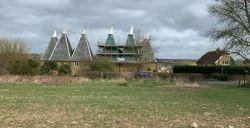Welsh Slate courts the competition in historical town
 Cwt Y Bugail is the material of choice for Lyons Roofing’s client.
Cwt Y Bugail is the material of choice for Lyons Roofing’s client.
When IT consultant Jonah Beck was looking to reroof his converted oast house, there was really only one option for the material – Welsh Slate.
The natural slate that had been used to reroof the 17th Century property when it was converted in 1982 had suffered from delamination due to the use of galvanised steel nails which had rotted.
But under the guardianship of specialist sub-contractor Lyons Roofing, the matching pair of oast roofs totalling 250m2, have been returned to their former glory, using reclaimed Cwt Y Bugail 20” x 10” slates. These were fixed, as Welsh Slate recommends, with copper nails.
The Welsh slates were sourced from reclaimed building materials supplier D&T Slate Buyers of Erith who had reclaimed them from a property in London and estimated them to be 40 years old.
Danny Lyons said: “They were in excellent condition and I would certainly expect they have a life span of at least 100 years left in them.
“We do use imported slates as we use products based on our clients’ specifications, requirements and budget, but Welsh Slate are, without doubt, a favourite of mine, and given a choice I would choose to work with a Welsh Slate, new or reclaimed, as they are far more superior to any Grade 1 imported slate, irrespective as to the fact these were already 40 years old! This comes with 30 years’ experience of working on historical buildings within the South East.”
Although the roofs of the other three oast houses at Court Lodge Farm in a Conservation Area in historical East Farleigh near Maidstone, Kent, had been reroofed with Welsh Slate, Jonah was under no obligation to use the same.
He went to several roofers for quotes. One suggested clay plain tiles, another imported slate, but it was Danny Lyon’s home-grown Welsh Slate option that won out. This was installed over open rafters in just over a month, and won Lyons Roofing a shortlisting in the “Best use of slate for a domestic project” category in the 2020 Pitched Roofing Awards.
“We went down the Welsh Slate route but not just to keep it in keeping with the other properties,” said Jonah. “The imported slate looked quite ‘plastic’ and Danny said the Welsh Slate would last a lot longer.”
Lyons Roofing, also of East Farleigh, stripped the original 70°-pitch roofs and barn at the back, battened them, fitted a new breathable membrane, and fixed the Cwt Y Bugail slates with the copper nails. Code 5 lead was fitted to the four hips with copper straps and Code 6 lead to the box gutter.
Danny Lyon added: “The project was started and completed to the client’s time scale despite the Covid pandemic commencing and the country going into lockdown whilst we were carrying it out.
“Thankfully, we were able to carry out risk assessments and ensure that safe working practices were adhered to which meant our staff were kept safe and we were able to continue and complete on time, without disruption or any additional costs or impact to the customer.
“The steepness of the pitch, which went over four scaffold lifts, did make access around the scaffold slightly more time consuming. But the use of Welsh reclaimed slate to bring this historical building back to life was a pleasure to work with. The Welsh Slate product was excellent.”
Formerly Church Field Oast, the development, which was constructed of nine-inch thick brickwork laid in Flemish bond, was last used to dry hops in the 1977 season.